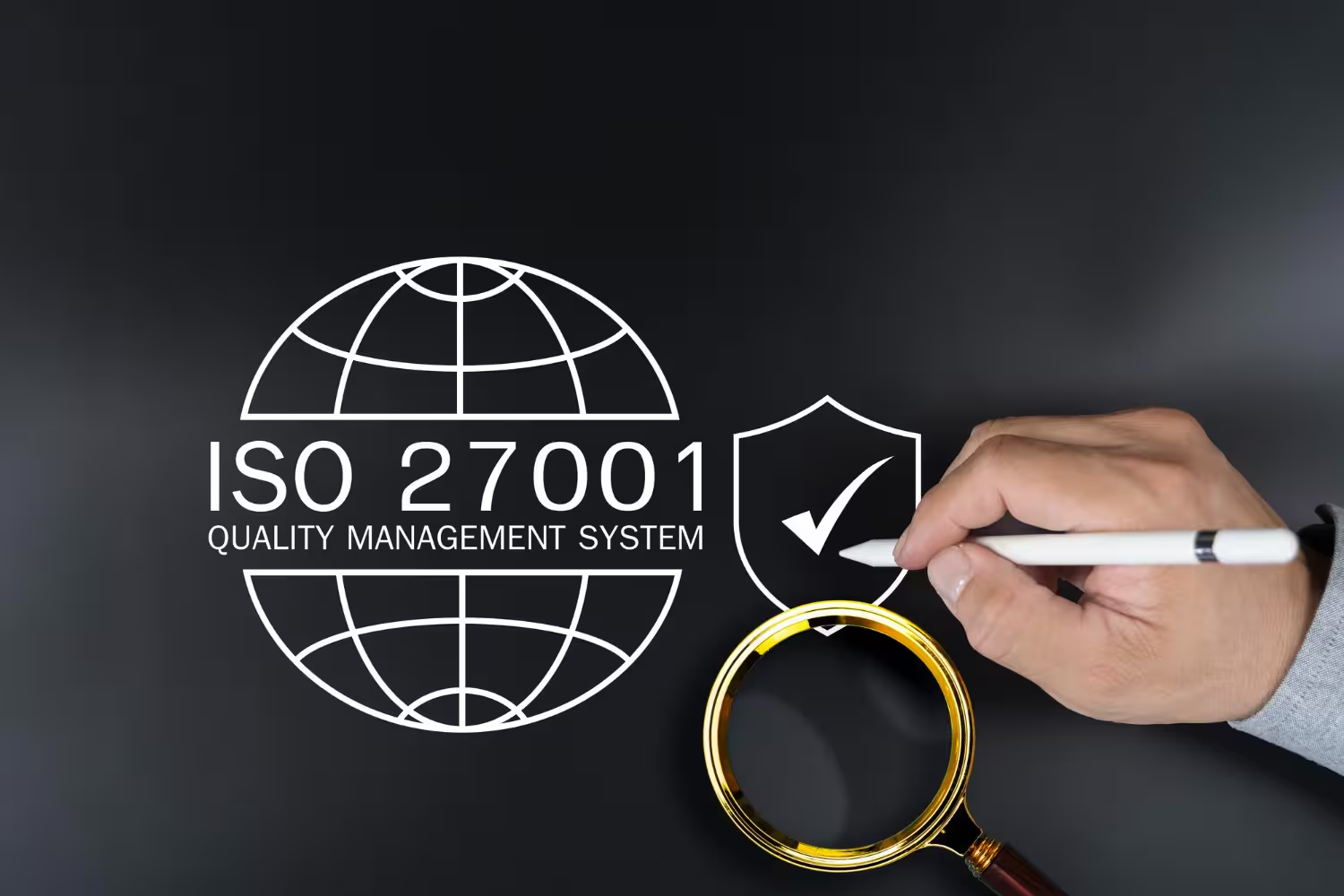Personal Protective Equipment for Nurses: Everything You Need to Know
Let’s take a look at everything you need to know about personal protective equipment for nurses.

Personal protective equipment (PPE) has been relevant in various industries for decades. PPE first originated during World War I to protect soldiers. Since the first rubber respirator, yes rubber, there have been many changes.
Of course, PPE also grew in popularity within the United States during the COVID-19 pandemic.
But what exactly is it?
PPE is the protective mask and goggles your dentist wears while cleaning your teeth. It also includes clothing, gloves, face shields, goggles, facemasks, and respirators.
It’s necessary in all areas of healthcare and failure to comply is the number one cause of transmitted diseases.

Why wear it?
Wearing PPE can prevent 36.7% of injury and disease.
Since it’s so important, the World Health Organization ensures all regions have access to PPE. Even still, there have been times when getting adequate PPE seemed impossible. Did you panic during COVID-19 because you couldn’t find a mask?
That's because there was a worldwide shortage of PPE. To stop this from ever happening again, the leading exporters, China, Germany, and the US, ensure widespread distribution.
PPE not only protects you as an employee but those around you as well. Wearing the correct equipment, and wearing it the proper way, can save your life, or someone else's life.
That’s why it's not just a preference in the healthcare space. It’s a requirement (more on that later). So, let’s take a look at everything you need to know about personal protective equipment for nurses.
Why PPE?
Healthcare professionals wear PPE in nearly all aspects of their careers.
It’s proven that PPE stops nearly 38% of injuries and diseases.
You might find yourself asking what happens if I don't wear any. Well, you just increased your chance of injuries by 12-14%.
The main reason why PPE exists is to protect yourself from bloodborne pathogens. A bloodborne pathogen is an infectious microorganism that lives within our blood.

These microorganisms carry diseases including hepatitis, HIV, miliaria, syphilis, and more. Knowing how bloodborne illnesses spread is essential for keeping everyone safe. That comes with training on bloodborne pathogens…which is also a requirement in the healthcare space.
Annual bloodborne pathogen training not only keeps our nurses safe, but our first responders, housekeeping personnel, and all other healthcare professionals. Staying up to date on how to prevent this exposure is critical.
Types of PPE
There are many types of PPE. Some get used daily, while others exist for special procedures only. It does not matter which type of PPE you’re using, they’re all important.
As I alluded to in the previous section, PPE exists across multiple industries, not just healthcare.
It’s equally as important for housekeeping personnel, construction workers, mining, and pharmaceutical companies. So, let’s take a look at the different types of PPE.
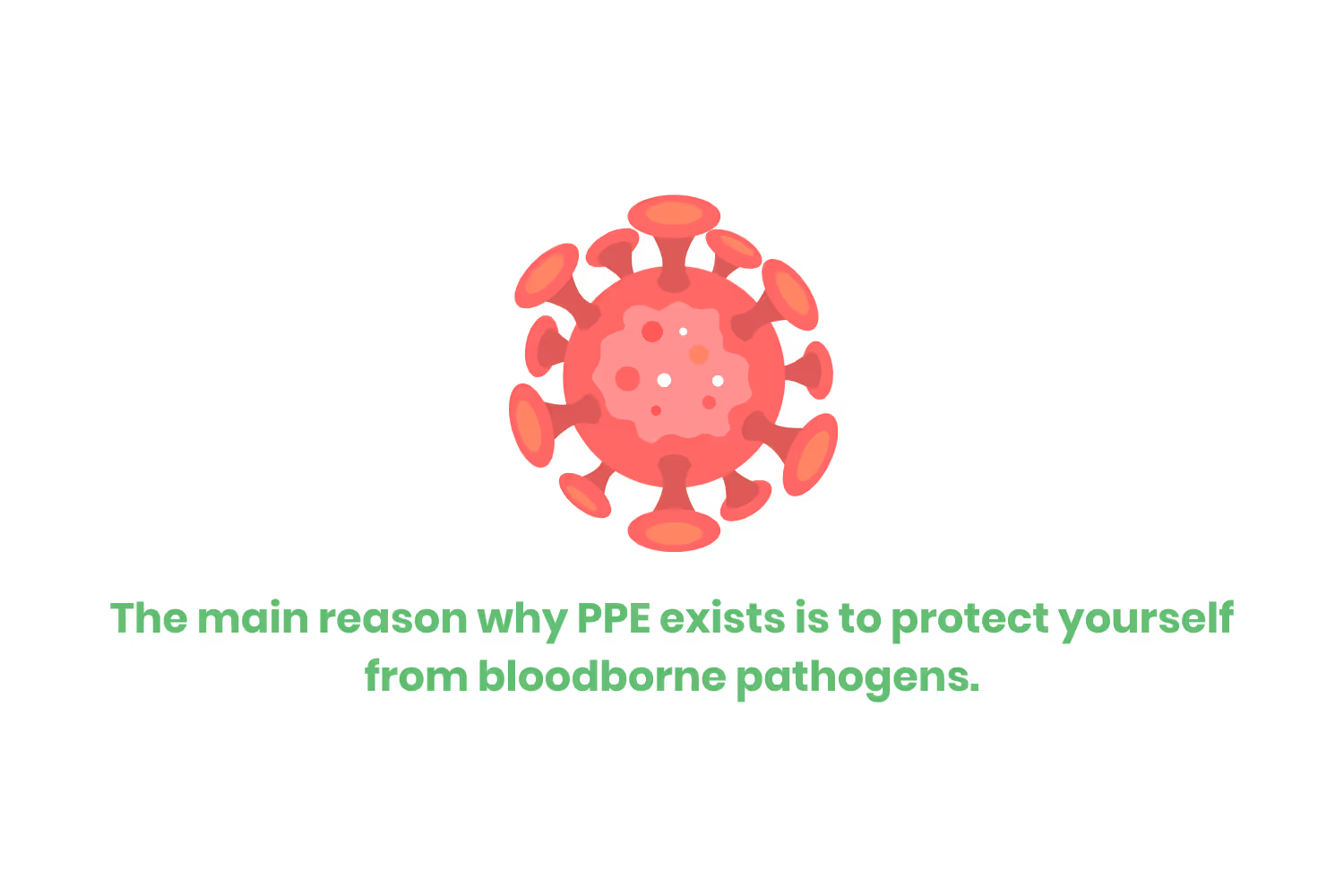
Masks
Masks are the most common form of PPE to protect against transmitting airborne viruses. 84% of Americans wore masks regularly during the COVID-19 pandemic. Masks are easy to use and dispose of. And they come in many different forms.
Starting with the mask that nearly all Americans used in 2020, the disposable face mask. These masks block droplets but don't protect against small particles or gasses. It’s hard to determine how well they filter the air around them.
Similar to the disposable face mask, a cloth mask is another common one used during the pandemic. This has the same effect as the disposable mask. Barrier face coverings are another form of mask, like the cloth mask. These filter the air you breathe out, which protects the people around you. It doesn’t protect you from particles.
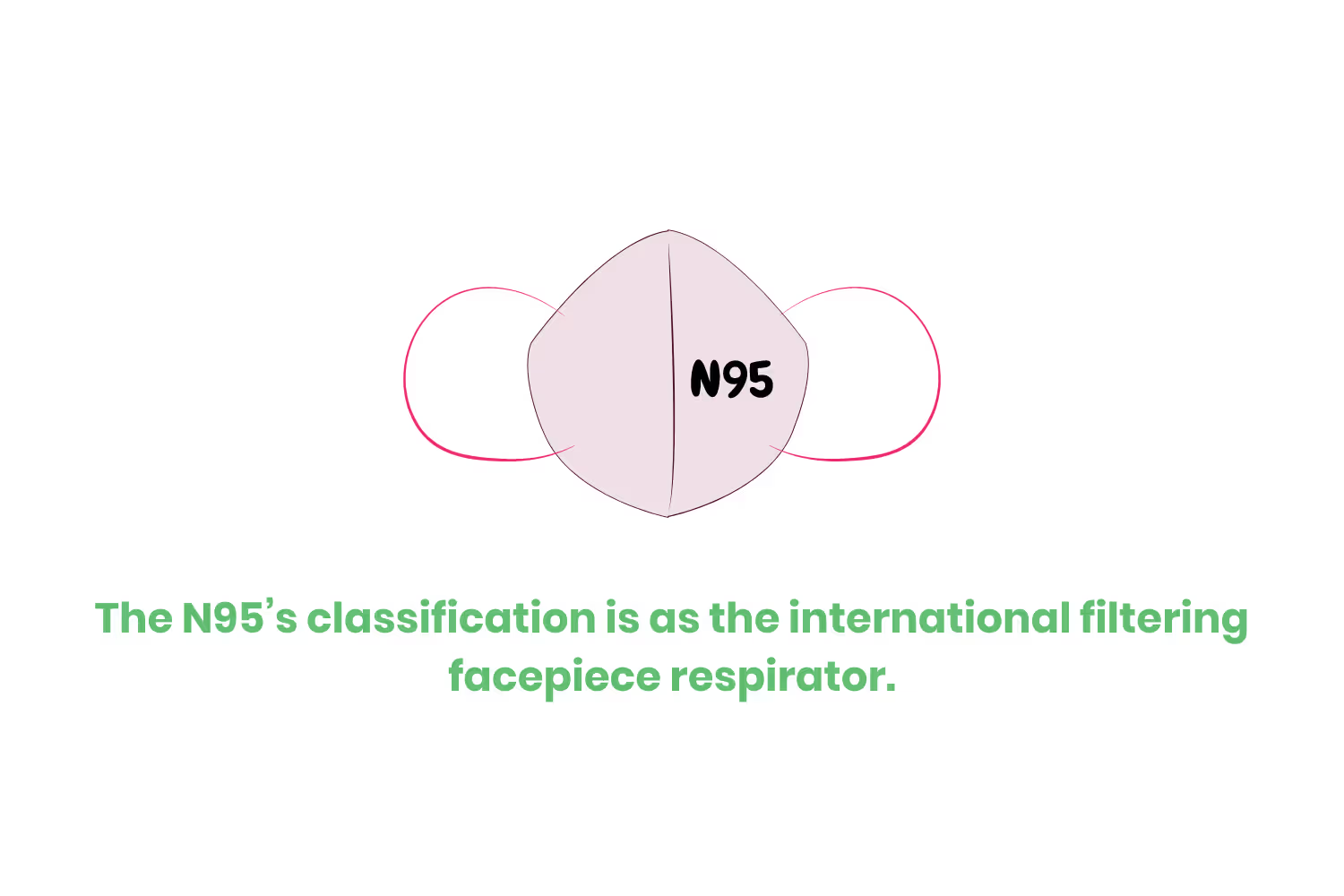
If you are looking for a mask to protect YOU from airborne particles, the N95 mask is the best option. The N95’s classification is as the international filtering facepiece respirator. Now you know why they gave it a nickname. The N95 mask filters tiny particles protecting you and those around you, but it’s harder to breathe in.
The last form of masks is the NIOSH-approved elastomeric half-mask respirator and elastomeric quarter-mask respirator. Now that one needs a nickname too. This mask fully protects you from gasses and vapors. It protects those around you as well by filtering the air as you inhale and exhale.
Gloves
Gloves are the most used form of PPE in hospitals. However, they’re used in chemistry, construction, housekeeping, and many more industries.
Gloves protect your hands from touching contaminated areas directly. They also protect your hands from sharp objects. Rubber gloves come in multiple sizes and they are sterile. It is important to have proper fitting gloves, you do not want one falling off during something important.
Goggles and face get used to protect your skin, eyes, nose, and mouth from splatters. This is an important step in protecting you from bodily fluids or harsh chemicals. Thus, they’re usually paired with masks.

Gowns
Gowns are essential for protecting your clothes from contamination. They are most commonly worn by healthcare professionals performing surgery.
This type of PPE is pretty self-explanatory.
Shoe & Head Coverings
The last form of PPE is shoe and head covers keeping yourself safe from head to toe. These are mainly relevant to construction workers, and healthcare professionals. Yes, hard hats are a form of PPE. OSHA requires them for miners, engineers, and construction workers. Shoe covers and shoe inspections see usage in both hospitals and fieldwork.
Ensuring Proper Use of PPE
Now that you know exactly what PPE is, let's see if you are wearing it right.
Wearing PPE the correct way means properly dressing before the procedure, and properly disposing of the contaminated pieces. This procedure’s official terms are donning and doffing.
It’s important to keep your hands away from your face at all times. This keeps yourself and the patient free from contamination. The misuse of PPE can result in serious consequences for yourself and others.
PPE Misuse
There are several ways to misuse PPE. Misuse of masks stands out as one of the most prevalent forms of PPE mishandling. After wearing a mask for a prolonged time, it becomes tempting to ignore their usage requirements.
But it’s important to know them.
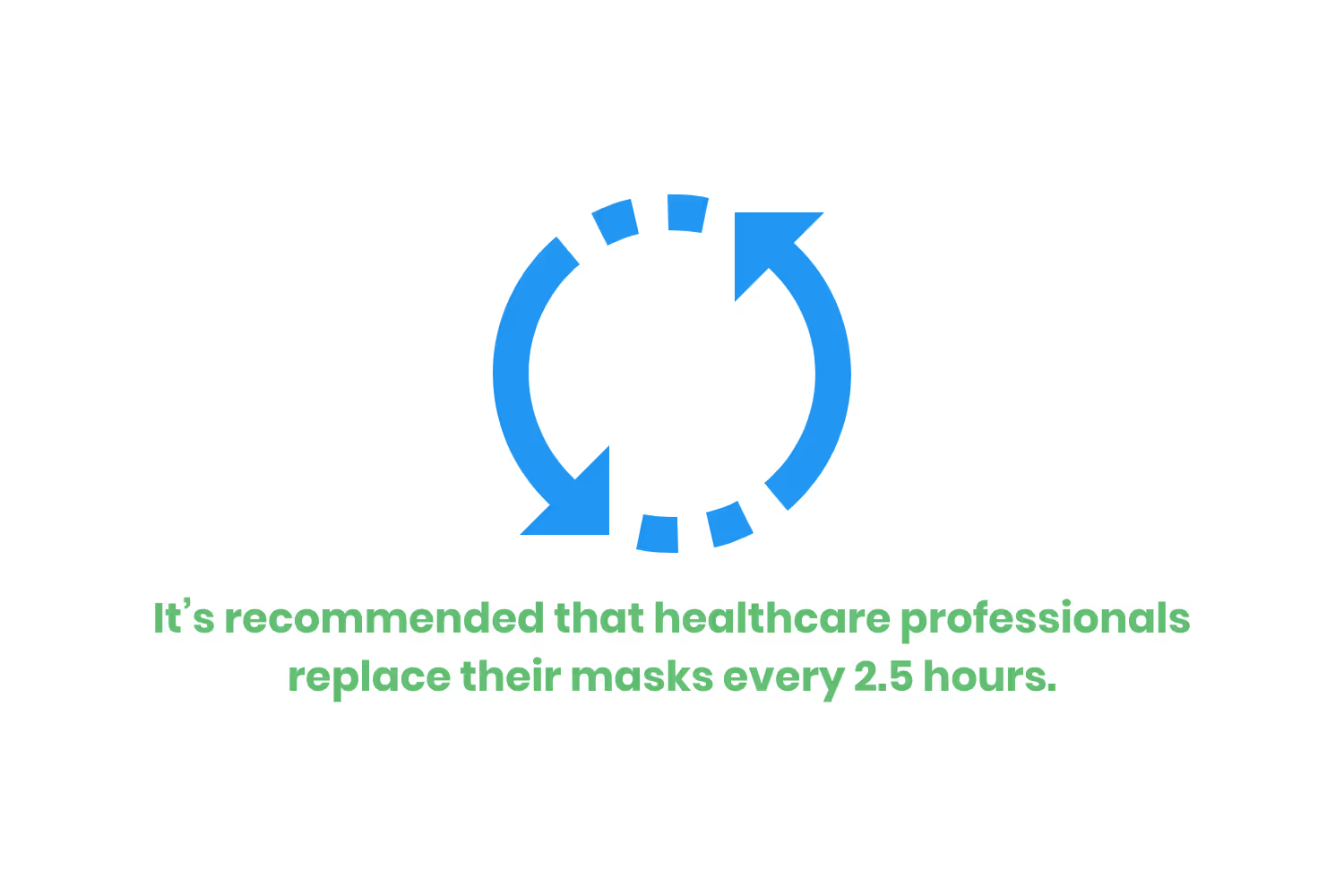
During the COVID-19 pandemic, many nurses had to wear masks for extended periods to protect themselves and others. The average duration they wore masks each day was reportedly 6.8 hours. In contrast, it’s recommended that healthcare professionals replace their masks every 2.5 hours.
Most misuses of PPE happen subconsciously. Some common misuses include reusing a gown for multiple patients, rolling up the gown's sleeves, and wearing contaminated pieces outside of the patient care area. A few other misuses stem from improper storage, using damaged PPE, or touching your mask throughout the day.
Sequence for Donning
80% of healthcare workers are knowledgeable of the proper donning and doffing process.
What about the other 20%?
Administrators need to train their employees on the do’s and don’ts of these sequences.
The correct sequence for donning (putting on) PPE is to begin by washing your hands.
The first step is to put on your gown ensuring everything from your neck to your knees is properly covered.
The mask is next. Make sure to tie the mask tightly, securing it around your nose. After the mask is stable, put on your goggles and gloves.
Make sure to cover any open skin on your face or arms; 27% of errors happen during this step. Don't be a part of that 27%.
Lastly, make sure all the PPE is properly fitted, or check if any piece is defective. You wouldn’t use a water bottle with a hole in it, right?
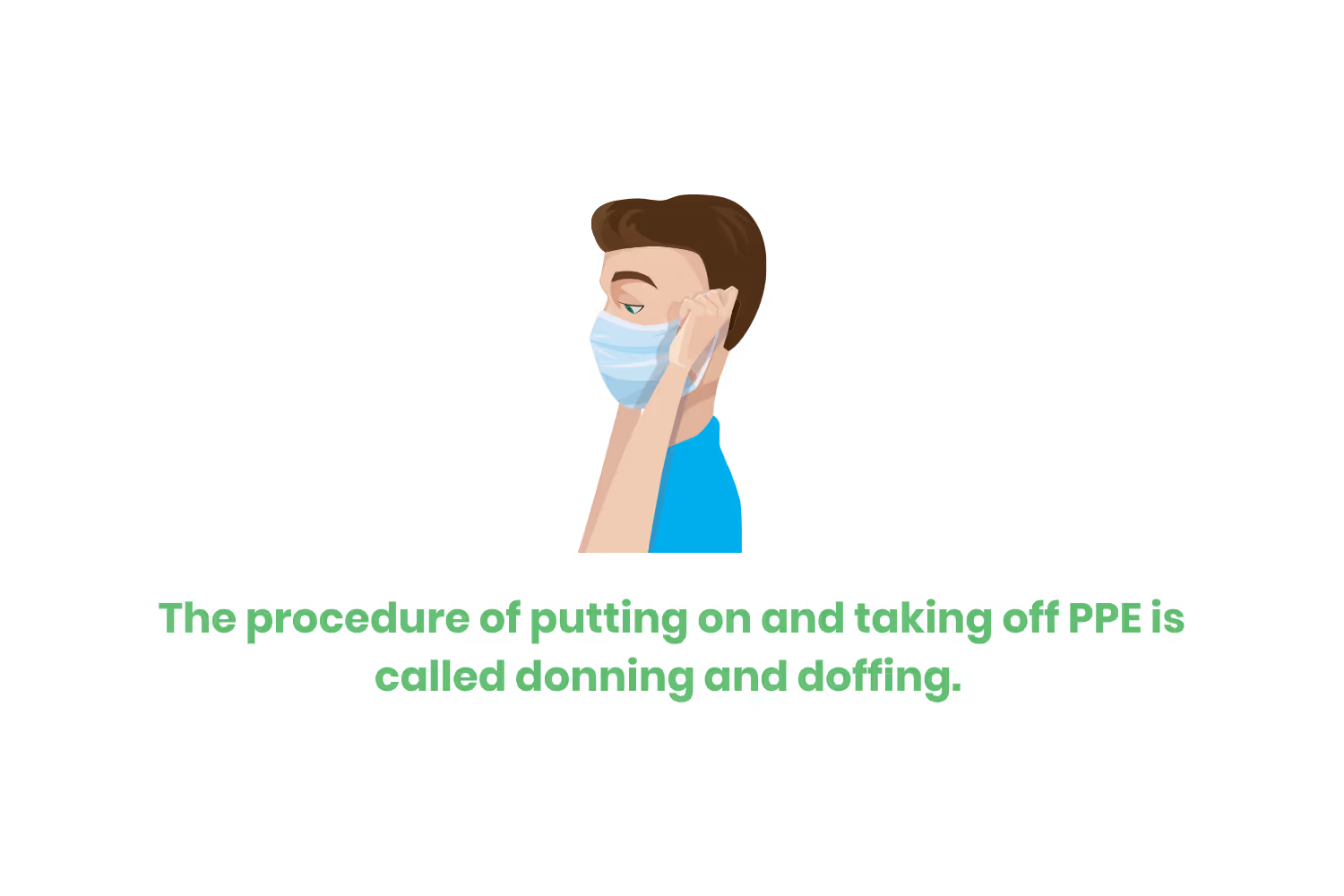
Sequence for Doffing
It’s crucial to wash your hands after each step while taking off PPE.
Begin by removing the gloves one at a time. After removing the first glove, carefully remove the second glove without touching the outside contaminated area.
Before moving on to removing the gown, sanitize your hands.
Remove the gown by pulling it away from you, only touching the inside. Next remove your goggles and mask, washing your hands in between of course.
Once you've removed all your PPE, it's essential to dispose of it correctly according to your facility's guidelines. The National Library of Medicine conducted a study regarding the donning and doffing process. Surprisingly, 17.2% of individuals failed to discard their PPE properly. Yikes.
The easiest way to stay safe while using PPE is simple.
Just follow the correct sequence for donning/doffing. Never share or reuse PPE. If it is wet or soiled, you probably are going to need a new piece. Keep your mask over your nose, and never touch the front. Lastly, wash your hands, a lot.
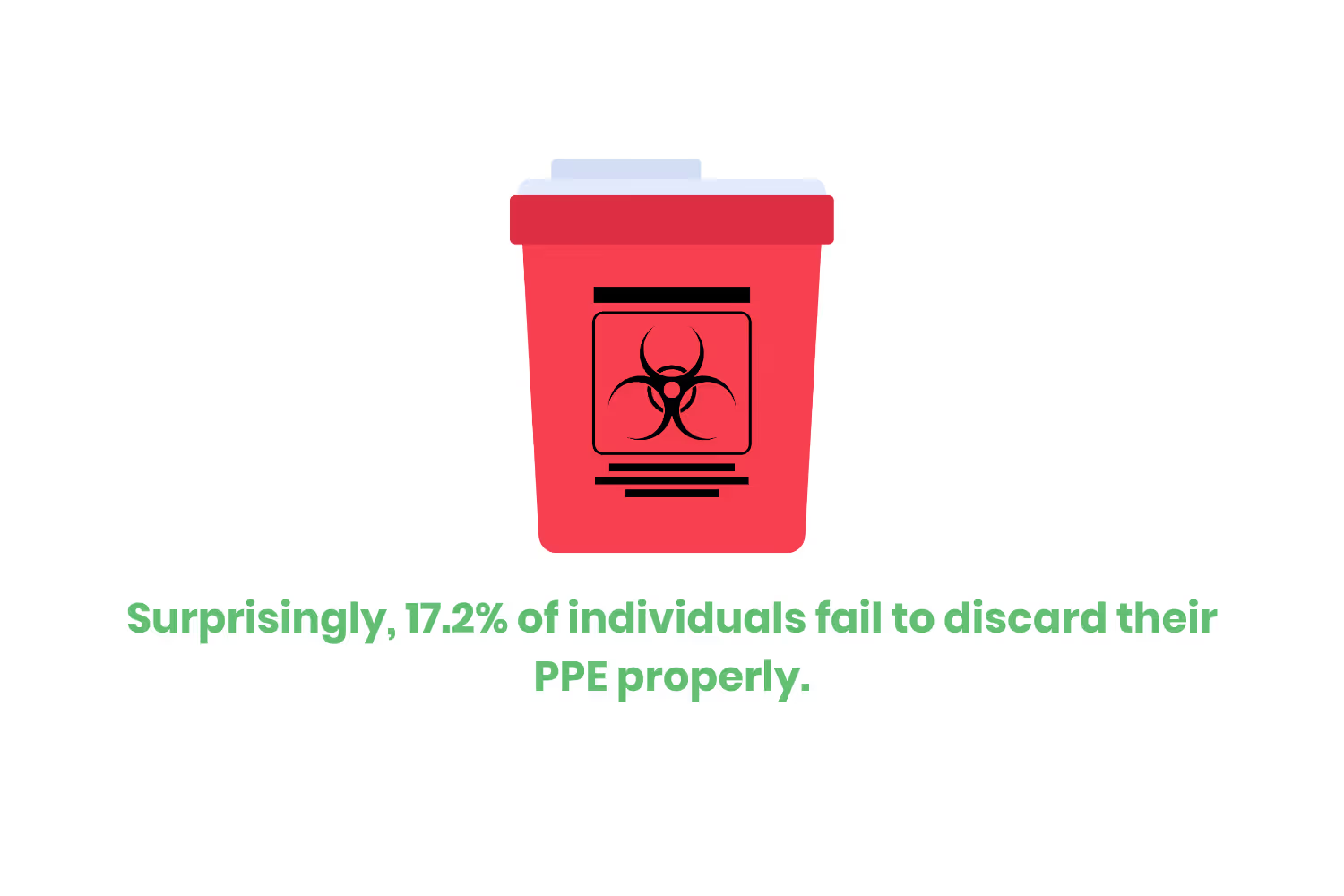
Employer Responsibilities
To keep the workplace safe and healthy, OSHA lays out employer responsibilities.
This includes employers analyzing their PPE protocols and adequately training their employees.
Making sure that employees wear PPE correctly is essential for maintaining workplace safety. As an employer, you should make sure to provide all appropriate PPE.
Training and Education
PPE training is important for motivating people to wear their PPE properly.
If you’re unsure of the impact PPE is making, you’re less likely to follow the recommendations. Knowing how to properly wear PPE is also important for employers to teach. Employers need to enforce annual training to keep their employees up to date on the latest guidelines and regulations.
Knowing what PPE protects its wearer from makes employees more inclined to use it. If someone told you that wearing a mask would decrease your chances of getting malaria, you wouldn’t think twice before putting one on. I know I wouldn't.
Knowing how to protect against bloodborne illnesses is an important lesson taught through training as well.
The Significance of PPE for Nurses
Nurses are the backbone of the healthcare industry.
They’re constantly going from one patient to another to administer medicine, and tests, and make patients more comfortable. Because of the large volume of patients they see in one day, they need to follow the correct protocols surrounding PPE.
Understanding how bloodborne pathogens transmit and how to properly wear PPE can save lives.
PPE is so prominent within nursing because of their exposure to many patients a day. Nurses need to take the proper precautions to keep themselves safe, like training.
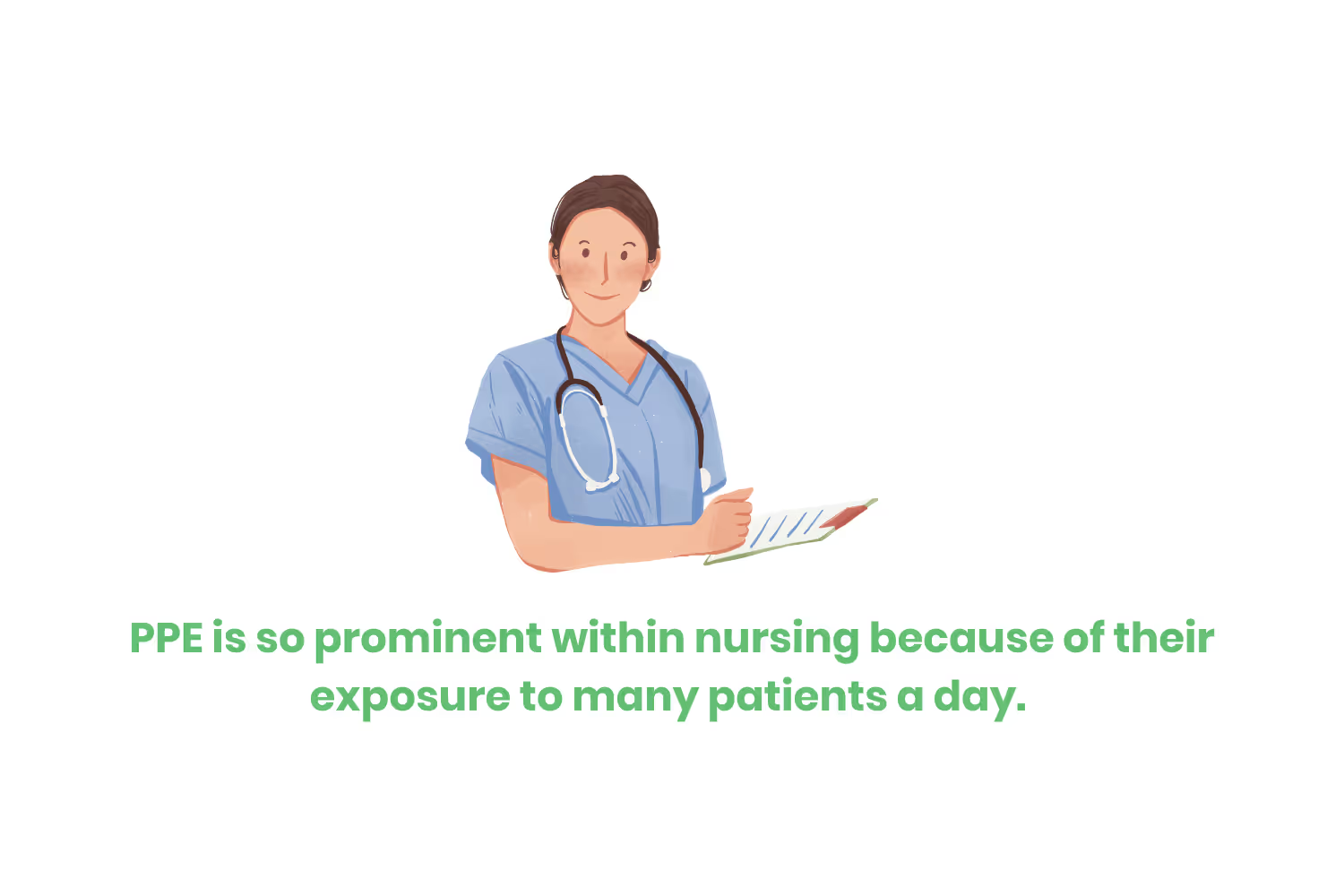
Impact of COVID-19 on Nurses
Nurses were on the frontline during the COVID-19 pandemic. The strain that COVID had, and still has, on nurses all around the world is threatening.
100,000 registered nurses had quit their jobs during the pandemic. It’s predicted that by 2027 the US will be down one-fifth of the 4.5 million nurses.
Nurses quit for many reasons, but the lack of adequate PPE was one of the main reasons during the pandemic.

The shortage of PPE at the time put the nurses and patients in danger. Nurses felt unsafe at work, especially as they were the most hands-on during the pandemic. There were times when nurses would be wearing the same gown for their entire shift, not knowing if their patients had the virus or not.
This is when the American Nurses Association (ANA) and the Occupational Safety and Health Administration (OSHA) had to get involved.
Supporting Nurses
Nurses are critical to our healthcare system. They’re the reason hospitals and doctor's offices function and it’s hard to imagine a healthcare system without them. It’s our job to keep our nurses happy and healthy. We can make their lives easier by doing simple things.
Following their instructions is a straightforward approach to alleviate some of their stress. It is understandable to feel frustrated when facing numerous tests or medications. However, trusting that nurses are there to help you is influential.
Life happens, and sometimes you are running late. But being on time for your appointments makes nurse's lives a whole lot easier. They’re used to seeing multiple patients a day, so being ready for them helps a lot.
It’s our job to protect nurses the best we can. Wearing PPE ourselves is the best way to ensure their safety. As we learned earlier, disposable masks only protect others from airborne pathogens. So if they’re wearing a mask for us, we can wear one for them.
We'll talk about nursing and mental health another time. But, remembering to be a good patient matters. With the shortage of nurses in the US since the pandemic, just being patient and polite can mean the world to a nurse.
A simple please and thank you can make or break their day.
Conclusion
PPE will remain relevant until bloodborne pathogens and viruses are gone forever. In other words, it’s not going anywhere.
Understanding PPE and taking annual blood pathogen training is the first step in combating transmission.
It’s one thing to know what a bloodborne pathogen is, but it becomes a bigger issue when you’re exposed to it every day. Annual training will ensure nurses, first responders, and housekeeping personnel stay safe in their everyday jobs.
Understanding the severity of PPE and taking bloodborne pathogen training could save a life.
Emphasize your product's unique features or benefits to differentiate it from competitors
In nec dictum adipiscing pharetra enim etiam scelerisque dolor purus ipsum egestas cursus vulputate arcu egestas ut eu sed mollis consectetur mattis pharetra curabitur et maecenas in mattis fames consectetur ipsum quis risus mauris aliquam ornare nisl purus at ipsum nulla accumsan consectetur vestibulum suspendisse aliquam condimentum scelerisque lacinia pellentesque vestibulum condimentum turpis ligula pharetra dictum sapien facilisis sapien at sagittis et cursus congue.
- Pharetra curabitur et maecenas in mattis fames consectetur ipsum quis risus.
- Justo urna nisi auctor consequat consectetur dolor lectus blandit.
- Eget egestas volutpat lacinia vestibulum vitae mattis hendrerit.
- Ornare elit odio tellus orci bibendum dictum id sem congue enim amet diam.
Incorporate statistics or specific numbers to highlight the effectiveness or popularity of your offering
Convallis pellentesque ullamcorper sapien sed tristique fermentum proin amet quam tincidunt feugiat vitae neque quisque odio ut pellentesque ac mauris eget lectus. Pretium arcu turpis lacus sapien sit at eu sapien duis magna nunc nibh nam non ut nibh ultrices ultrices elementum egestas enim nisl sed cursus pellentesque sit dignissim enim euismod sit et convallis sed pelis viverra quam at nisl sit pharetra enim nisl nec vestibulum posuere in volutpat sed blandit neque risus.

Use time-sensitive language to encourage immediate action, such as "Limited Time Offer
Feugiat vitae neque quisque odio ut pellentesque ac mauris eget lectus. Pretium arcu turpis lacus sapien sit at eu sapien duis magna nunc nibh nam non ut nibh ultrices ultrices elementum egestas enim nisl sed cursus pellentesque sit dignissim enim euismod sit et convallis sed pelis viverra quam at nisl sit pharetra enim nisl nec vestibulum posuere in volutpat sed blandit neque risus.
- Pharetra curabitur et maecenas in mattis fames consectetur ipsum quis risus.
- Justo urna nisi auctor consequat consectetur dolor lectus blandit.
- Eget egestas volutpat lacinia vestibulum vitae mattis hendrerit.
- Ornare elit odio tellus orci bibendum dictum id sem congue enim amet diam.
Address customer pain points directly by showing how your product solves their problems
Feugiat vitae neque quisque odio ut pellentesque ac mauris eget lectus. Pretium arcu turpis lacus sapien sit at eu sapien duis magna nunc nibh nam non ut nibh ultrices ultrices elementum egestas enim nisl sed cursus pellentesque sit dignissim enim euismod sit et convallis sed pelis viverra quam at nisl sit pharetra enim nisl nec vestibulum posuere in volutpat sed blandit neque risus.
Vel etiam vel amet aenean eget in habitasse nunc duis tellus sem turpis risus aliquam ac volutpat tellus eu faucibus ullamcorper.
Tailor titles to your ideal customer segment using phrases like "Designed for Busy Professionals
Sed pretium id nibh id sit felis vitae volutpat volutpat adipiscing at sodales neque lectus mi phasellus commodo at elit suspendisse ornare faucibus lectus purus viverra in nec aliquet commodo et sed sed nisi tempor mi pellentesque arcu viverra pretium duis enim vulputate dignissim etiam ultrices vitae neque urna proin nibh diam turpis augue lacus.


